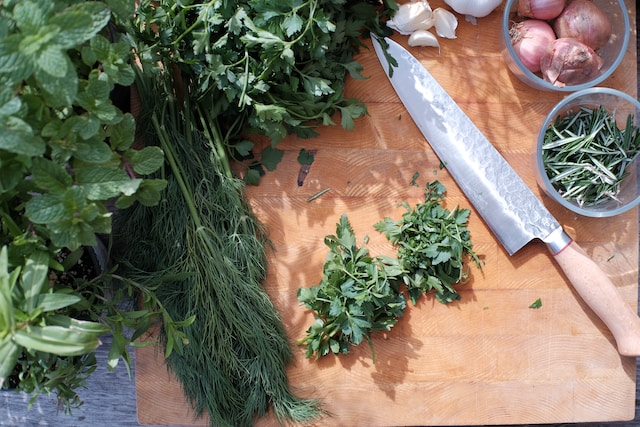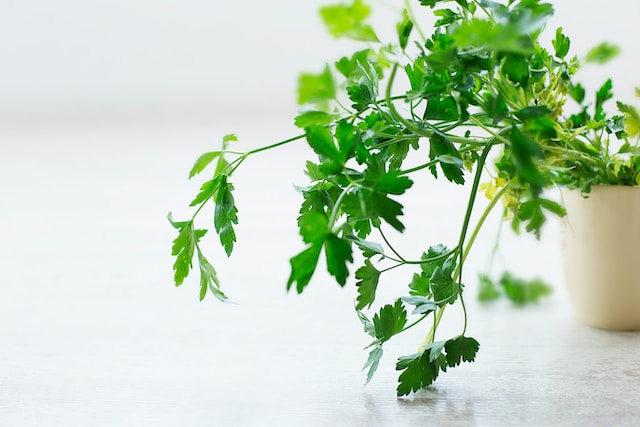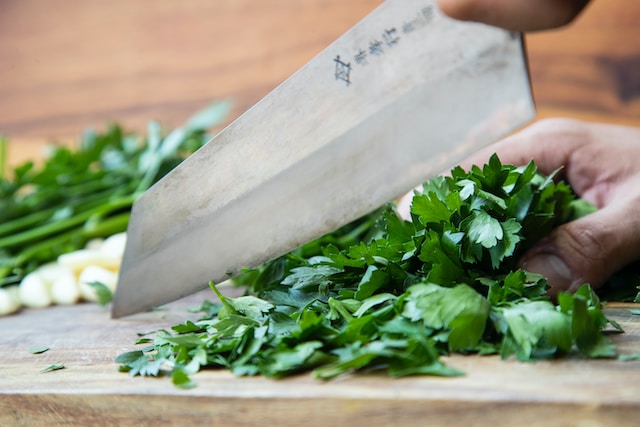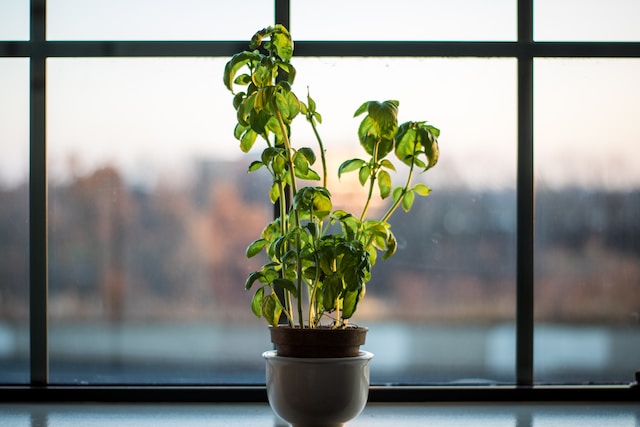
The aroma of fresh herbs, the flavor profiles they offer, and the health benefits they provide – that’s what makes cooking with herbs a delightful experience. From basil to mint, from thyme to rosemary, herbs add a pop of freshness and zing to any dish you whip up.
Basil, with its sweet anise-like flavor, is a go-to herb for making pesto and adding depth to tomato-based dishes. Mint, on the other hand, has a cool, refreshing taste and is perfect for salads, drinks, and desserts. Thyme is a hearty herb with a woodsy aroma that pairs well with poultry, fish, and vegetables. Rosemary adds a smoky, piney flavor to meat dishes and roasted potatoes.
But herbs are not just flavor enhancers. They come with an array of health benefits too. For example, parsley is a powerhouse of vitamins A, C, and K, while cilantro is known to be rich in antioxidants and aid in digestion. Sage, a staple in Mediterranean cuisine, has anti-inflammatory properties, and oregano, a popular herb in Italian cooking, is high in antioxidants and can help ward off infections.
Growing herbs at home is easy and requires little effort. You can cultivate them in pots or a small herb garden in your backyard. Not only do they make your dishes taste delicious, but they also bring nature into your kitchen and make it look more inviting.
Popular Culinary Herbs
As you explore the world of cooking with herbs, you’ll discover that there are countless options to choose from, each with their own unique properties and flavor profiles. Here are some more popular culinary herbs to consider adding to your collection.
Dill – Known for its distinct tangy flavor, dill is commonly used in pickling and seafood dishes. It’s also a great source of vitamin C and can aid in digestion.
Chives – With their mild onion-like flavor, chives are often used in soups, salads, and as a garnish. They contain antioxidants and can help lower blood pressure.
Bay leaves – These aromatic leaves are often used to flavor stews, soups, and sauces. They have antibacterial properties and can help improve respiratory function.
Lemongrass – A staple in Thai and Vietnamese cooking, lemongrass adds a fresh, citrusy flavor to dishes. It’s also believed to have anti-inflammatory and anti-cancer properties.

Parsley – In addition to being rich in vitamins A, C, and K, parsley has detoxifying properties and can freshen breath. It’s commonly used as a garnish or to add freshness to dishes.
Experimenting with different herbs and spices is a fun and delicious way to explore new flavors and enhance your cooking skills.
Culinary Uses of Herbs
As the world becomes more health-conscious, the use of herbs in culinary creations has become increasingly popular. From ancient times, herbs have been used not only for their flavor but also for their medicinal properties. If you’re new to using herbs in your cooking, don’t be intimidated. Here are some tips for incorporating herbs into everyday cooking.
Start with the basics
Some herbs are more versatile than others, making them easier to incorporate into varied dishes. Basil, cilantro, parsley, rosemary, and thyme are common herbs that can be used in several ways. Once you’re comfortable with these, feel free to experiment with other herbs.
Use herbs that complement your dish
Certain herbs pair well with certain types of foods, so it’s essential to use them strategically. For example, rosemary or thyme are perfect for seasoning red meat, while basil or sage are better for seasoning chicken or fish. You don’t want the herbs to overpower the food or clash with the other flavors in the dish.
Don’t overdo it

When using fresh herbs, be mindful of the quantity. Fresh herbs have a more potent flavor than dried herbs, so you’ll need less. A general rule of thumb is to use one tablespoon of fresh herbs for every teaspoon of dried herbs.
Timing is key
Remember to add herbs at the right time. Different herbs require different cooking times to bring out their full flavor. For example, delicate herbs like basil and parsley should be added at the end of the cooking process, while heartier herbs like rosemary and thyme can be added at the beginning.
Visuals matter
Don’t forget to appreciate the visual appeal of herbs. Using fresh herbs to garnish a dish not only adds flavor but also makes the dish look more appealing. Chopped parsley or cilantro sprinkled on top of a soup or salad, for example, can make it more visually inviting.
Herb-Infused Oils and Vinegars
If you want to take your love for herbs to the next level, herb-infused oils and vinegars are a great way to do so. These are simple to make at home and can add extra flavor to your dishes. Here are some popular herb-infused oils and vinegars you can make at home.
Herb-infused oils:
- Rosemary oil – This is perfect for adding depth to roasted potatoes and meats.
- Basil oil – Drizzle this oil on salads or pasta dishes to add a pop of freshness.
- Thyme oil – Use this oil to marinate chicken or fish and enjoy its earthy aroma.
- Garlic oil – Use this versatile oil to sauté vegetables or to drizzle over pizzas.
- Lemon oil – Use this oil to add a citrusy tang to dressings, sauces, and marinades.
Herb-infused vinegars:
- Tarragon vinegar – This vinegar is perfect for dressing salads or marinating fish.
- Mint vinegar – Use this vinegar to add a refreshing twist to fruit salads or to marinate lamb or pork.
- Dill vinegar – Perfect for pickling vegetables or as a marinade for seafood.
- Sage vinegar – Add this vinegar to soups and stews to give them a woodsy flavor.
- Cilantro vinegar – Drizzle this vinegar on tacos or use it to marinate chicken or fish.
To make herb-infused oils or vinegars at home, simply combine your desired herbs with oil or vinegar and let them infuse for a few days. Strain out the herbs and use the flavored oil or vinegar in your dishes. Not only are these homemade infusions flavorful, they also make for great homemade gifts for the foodies in your life.
Culinary Uses of Herbs
When it comes to cooking with herbs, the possibilities are truly endless. Here are some ideas to help inspire you to incorporate more herbs into your daily dishes:
- Adding fresh herbs to any salad is a fantastic way to add flavor without adding calories. Try sprinkling a handful of chopped fresh parsley, basil, or cilantro over your favorite greens, or mix in some fresh mint or dill for a zesty kick.
- For a simple yet flavorful marinade, combine some chopped garlic, fresh rosemary and thyme, and a splash of olive oil. Use this to marinate chicken, tofu, or your favorite veggies.

- Herb-infused butters are a delicious way to add a burst of flavor to anything – from toast to steak. Try mixing softened butter with chopped fresh herbs like parsley, tarragon, or chives, and spread it on warm bread or melt it over hot grilled meat.
- Herbs can even add some excitement to your morning routine. Add some fresh dill or chives to your scrambled eggs, mix some chopped basil into your omelet, or sprinkle some chopped cilantro on your avocado toast.
- Bring some extra flavor to your soups and stews by adding a few sprigs of thyme or bay leaves during the cooking process. These hearty herbs can add depth and earthiness to your dish.
- For a flavorful salad dressing, mix some finely minced garlic, fresh lemon juice, and chopped fresh parsley with olive oil, salt, and pepper. Toss this with your favorite greens for a zingy salad.
- Don’t forget that herbs can even add flavor to your beverages. Add some fresh mint or basil leaves to your water or cocktails for a refreshing burst of flavor.
Remember, cooking with herbs is all about experimentation and finding what works for you and your taste preferences. Try out different combinations and let your taste buds lead the way!
Herbal Garnishes and Decorations
Using herbs as garnishes and decorations not only adds visual appeal to your dishes but also introduces new flavors and aromas. Here are some ideas to get you started:
Herb Bouquet: Tie together a bunch of fresh herbs like rosemary, thyme, and sage with a decorative ribbon to create a beautiful and aromatic bouquet. Use it as a centerpiece for your dinner table or as a decoration for your kitchen.
Herb-infused Salt: Combine your favorite herbs with coarse sea salt to make a flavorful and aromatic seasoning that can be used to enhance the taste of meat, vegetables, and salads.
Herb Butter: Mix softened butter with finely chopped herbs like parsley, chives, and tarragon to make a delicious spread that can be used on bread or as a topping for grilled meats.
Herb Oil Drizzle: Mix finely chopped herbs with olive oil to make a flavorful drizzle that can be used to add extra flavor to pasta dishes, soups, and salads.
Herb Salad: Mix together a variety of fresh herbs like parsley, cilantro, and mint with lettuce and other salad greens to make a fresh and flavorful herb salad.
Herb-infused Water: Add fresh herbs like basil or mint to a pitcher of water to create a refreshing and tasty drink that can be enjoyed any time of the day.
Herb Ice Cubes: Freeze chopped herbs in ice cube trays with water or broth to add a burst of flavor to your favorite drinks or soups.
Pairing Herbs with Food and Drinks

Pairing herbs with food and drinks is an art that can elevate the flavors and create a delightful culinary experience. The right combination of herbs can enhance the taste profile of dishes, add complexity, and bring a fresh aromatic element to the table. Here are some recommendations and tips to help you master the art of pairing herbs with specific ingredients, cuisines, and beverages:
Balancing Flavor
- Consider the intensity of flavors in both the herb and the dish. Delicate herbs like parsley and chives work well with lighter dishes, while robust herbs like rosemary and thyme complement heartier flavors.
- Experiment with contrasting flavors. Pairing mint with spicy dishes or basil with acidic ingredients can create a harmonious balance.
- Remember that herbs have different strengths, so use them judiciously to avoid overpowering the other flavors in the dish.
Herb-Infused Combinations
- Italian Cuisine: Basil pairs beautifully with tomatoes, mozzarella, and balsamic vinegar, while oregano complements pizza, pasta sauces, and grilled vegetables.
- Mediterranean Cuisine: Mint works well with lamb dishes, yogurt-based sauces, and citrus-infused salads, while dill complements seafood, tzatziki, and roasted vegetables.
- Asian Cuisine: Cilantro enhances the flavors of Thai curries, stir-fries, and Vietnamese pho, while lemongrass adds a citrusy note to soups, marinades, and teas.
- Mexican Cuisine: Cilantro and lime are a classic combination used in salsas, guacamole, and Mexican street corn, while Mexican oregano adds depth to chili, enchiladas, and mole sauces.
Herb and Protein Pairings

- Poultry: Sage pairs well with chicken and turkey, especially when used in stuffing or pan sauces. Rosemary complements roasted or grilled chicken dishes.
- Seafood: Dill complements salmon, trout, and seafood salads, while thyme enhances the flavors of grilled fish and shrimp.
- Red Meat: Thyme and rosemary work well with beef and lamb, whether used in marinades, rubs, or roasted dishes.
Herb-Infused Beverages
- Mint is a classic herb for refreshing beverages like mojitos, iced tea, and lemonade.
- Basil adds a unique twist to cocktails and mocktails, such as strawberry basil margaritas or cucumber basil lemonade.
- Rosemary-infused syrups or sprigs can be used in craft cocktails or infused into sparkling water for a refreshing twist.
With a bit of creativity and exploration, you can create harmonious herb-infused combinations that will tantalize your taste buds and impress your guests.
The world of herbs is vast and full of exciting possibilities. Whether you’re a seasoned chef or a beginner cook, incorporating herbs into your dishes can elevate and transform your culinary creations. From enhancing flavors to providing health benefits, herbs are a versatile and essential ingredient that should be a staple in any kitchen. So go ahead and experiment with different herbs, try out new combinations, and don’t be afraid to let your taste buds lead the way. Happy cooking!
